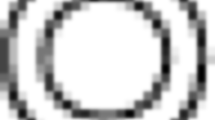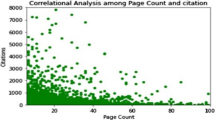Abstract
The number of citations has been widely used for scientific evaluation of publications and even institutions and individual scientists. However, there is as yet no satisfactory consensus as to when and how citation metrics should be applied. Therefore, it is of great importance to comprehend the factors which influence citations. The purpose of this study is to identify more such factors in order to better understand the dynamics of citations. We first collected articles in Library & Information Science journals indexed by the Chinese Social Science Citation Index. Then, we established reliable schemes to identify and record a total of 66 candidate factors—related to articles, authors, references and citations—which had not been comprehensively studied before. Bivariate analysis was applied to explore the relationship between those factors and citations, and forward stepwise regression was used to select predictive factors. We found that 46 factors were significantly associated with citations, from which six most significant factors were selected by a regression model. Possible strategies were hence proposed for identifying high-quality and high-impact articles.
Similar content being viewed by others
References
Amara, N., Landry, R., & Halilem, N. (2015). What can university administrators do to increase the publication and citation scores of their faculty members? Scientometrics, 103(2), 489–530.
Antoniou, G. A., Antoniou, S. A., Georgakarakos, E. I., Sfyroeras, G. S., & Georgiadis, G. S. (2015). Bibliometric analysis of factors predicting increased citations in the vascular and endovascular Literature. Annals of Vascular Surgery, 29, 286–292.
Ayres, I., & Vars, F. E. (2000). Determinants of citations to articles in elite law reviews. Journal of Legal Studies, 29, 427–450.
Berenson, M. L., & Levine, D. M. (1993). Statistics for business and economics. Englewood Cliffs, NJ: Prentice Hall.
Bhat, M. H. (2009). Effect of peer review on citations in the open access environment. Library Philosophy & Practice, 6, 1–6.
Bornmann, L. (2011). Scientific peer review. Annual Review of Information Science and Technology, 45(1), 197–245.
Bornmann, L., & Leydesdorff, L. (2015). Does quality and content matter for citedness? A comparison with para-textual factors and over time. Journal of Informetrics, 9(3), 419–429.
Chakraborty, T., Kumar, S., Goyal, P., Ganguly, N., & Mukherjee, A. (2014). Towards a stratified learning approach to predict future citation counts. In ACM/IEEE Joint Conference on Digital Libraries (JCDL), London, UK, pp. 351–360.
Chung, C. J., Nam, Y., & Stefanone, M. A. (2012). Exploring online news credibility: The relative influence of traditional and technological factors. Journal of Computer-Mediated Communication, 17, 171–186.
Cohen, J. (1988). Statistical power analysis for the behavioral sciences (2nd ed.). Hillsdale, NJ: Lawrence Erlbaum Associates, Publishers.
Crossick, G. (2016). Monographs and open access. Insights, 29(1), 14–19.
Cumming, G., & Calin-Jageman, R. (2017). Introduction to the new statistics. New York: Routledge.
Dalen, H. P., & Henkens, K. (2001). What makes a scientific article influential? The case of demographers. Scientometrics, 50(3), 455–482.
Dalen, H. P., & Henkens, K. (2005). Signals in science—On the importance of signaling in gaining attention in science. Scientometrics, 64(2), 209–233.
Didegah, F., & Thelwall, M. (2013). Which factors help authors produce the highest impact research? Collaboration, journal and document properties. Journal of Informetrics, 7, 861–873.
Garfield, E. (1979). Citation indexing—Its theory and application in science, technology, and humanities. New York: Wiley.
Glänzel, W., & Schubert, A. (1995). Predictive aspects of a stochastic model for citation processes. Information Processing and Management, 31(1), 69–80.
Hajjem, C., Harnad, S., & Gingras, Y. (2005). Ten-year cross-disciplinary comparison of the growth of open access and how it increases research citation impact. Bulletin of the IEEE Computer Society Technical Committee on Data Engineering, 28, 39–47.
Haslam, N., Ban, L., Kaufmann, L., Loughnan, S., Peters, K., Whelan, J., et al. (2008). What makes an article influential? Predicting impact in social and personality psychology. Scientometrics, 76(1), 169–185.
Haslam, N., & Koval, P. (2010). Predicting long-term citation impact of articles in social and personality psychology. Psychological Reports, 106(3), 891–900.
Hegarty, P., & Walton, Z. (2012). The consequences of predicting scientific impact in psychology using journal impact factors. Perspectives on Psychological Science, 7(1), 72.
Henderson, J. K. (2005). Language diversity in international management teams. International Studies of Management & Organization, 35(1), 66–82.
Hlimer, C. E., & Lusk, J. L. (2009). Determinants of citations to the agricultural and applied economics association journals. Review of Agricultural Economics, 31(4), 677–694.
Hurley, L. A., Ogier, A. L., & Torvik, V. I. (2013). Deconstructing the collaborative impact: article and author characteristics that influence citation count. ASIS&T Annual Meeting, Beyond the Cloud: Rethinking Information Boundaries, Montreal, Canada, p. 61.
Jamali, H. R., & Nikzad, M. (2011). Article title type and its relation with the number of downloads and citations. Scientometrics, 88(2), 653–661.
Jesús, R. R., & José, M. S. M. (2004). Patterns of the foreign contributions in some domestic vs. international journals on Earth Sciences. Scientometrics, 59(1), 95–115.
Larivière, V., Archambault, É., Gingras, Y., & Vignola-Gagné, É. (2006). The place of serials in referencing practices: Comparing natural sciences and engineering with social sciences and humanities. Journal of the American Society for Information Science and Technology, 57(8), 997–1004.
Leimu, R., & Koricheva, J. (2005). What determines the citation frequency of ecological papers? Trends in Ecology & Evolution, 20(1), 28.
Li, J., Sanderson, M., Willett, P., Norris, M., & Oppenheim, C. (2010). Ranking of library and information science researchers: Comparison of data sources for correlating citation data, and expert judgments. Journal of Informetrics, 4(4), 554–563.
Lokker, C., McKibbon, K. A., McKinlay, R. J., Wilczynski, N. L., & Haynes, R. B. (2008). Prediction of citation counts for clinical articles at two years using data available within three weeks of publication: Retrospective cohort study. British Medical Journal, 336, 655–657.
Lombard, M., Snyder-Duch, J., & Bracken, C. C. (2002). Content analysis in mass communication: Assessment and reporting of intercoder reliability. Human Communication Research, 28(4), 587–604.
Mingers, J., & Xu, F. (2010). The drivers of citations in management science journals. European Journal of Operational Research, 205(2), 422–430.
Ministry of Education of the PRC. (2005). A directory of disciplines and specialties for postgraduates, master and Ph.D. http://www.cdgdc.edu.cn/xwyyjsjyxx/sy/glmd/264462.shtml. Accessed 11 April 2018.
National Library of China. (2010). Book classification of China (5th ed.). Beijing: The Press of National Library of China.
Nolen, D. S. (2014). Publication and language trends of references in Spanish and Latin American literature. College & Research Libraries, 75(1), 34–35.
Oppenheim, C. (1995). The correlation between citation counts and the 1992 Research Assessment Exercise Ratings for British library and information science university departments. Journal of Documentation, 51(1), 18–27.
Qian, Y., Rong, W., Jiang, N., Tang, J., & Xiong, Z. (2017). Citation regression analysis of computer science publications in different ranking categories and subfields. Scientometrics, 110(3), 1–24.
Raan, A. F. J. (2006). Comparison of the Hirsch-index with standard bibliometric indicators and with peer judgment for 147 chemistry research groups. Scientometrics, 67(3), 491–502.
Ried, L. D., & McKenzie, M. (2004). A preliminary report on the academic performance of pharmacy students in a distance education program. American Journal of Pharmaceutical Education, 68(3), 65.
Rigby, J. (2013). Looking for the impact of peer review: does count of funding acknowledgements really predict research impact? Scientometrics, 94, 57–73.
Rostami, F., Mohammadpoorasl, A., & Hajizadeh, M. (2014). The effect of characteristics of title on citation rates of articles. Scientometrics, 98(3), 2007–2010.
Roth, C., Wu, J., & Lozano, S. (2012). Assessing impact and quality from local dynamics of citation networks. Journal of Informetrics, 6(1), 111–120.
Royle, P., Kandala, N. B., Barnard, K., & Waugh, N. (2013). Bibliometrics of systematic reviews: Analysis of citation rates and journal impact factors. Systematic Reviews, 2, 74.
Sabatier, M., & Chollet, B. (2017). Is there a first mover advantage in science? Pioneering behavior and scientific production in nanotechnology. Research Policy, 46, 522–533.
Schlögl, C., Gorraiz, J., Gumpenberger, C., Jack, K., & Kraker, P. (2014). Comparison of downloads, citations and readership data for two information systems journals. Scientometrics, 101(2), 1113–1128.
Sin, S. C. J. (2011). International coauthorship and citation impact: A bibliometric study of six LIS journals, 1980–2008. Journal of the American Society for Information Science and Technology, 62(9), 1770–1783.
Skilton, P. F. (2006). A comparative study of communal practice: Assessing the effects of taken-for-granted-ness on citation practice in scientific communities. Scientometrics, 68(1), 73–96.
Slyder, J. B., Stein, B. R., Sams, B. S., Walker, D. M., Beale, B. J., Feldhaus, J. J., et al. (2011). Citation pattern and lifespan: A comparison of discipline, institution, and individual. Scientometrics, 89, 955–966.
Sooryamoorthy, R. (2017). Do types of collaboration change citation? A scientometric analysis of social science publication in South Africa. Scientometrics, 111, 379–400.
Stremersch, S., Camacho, N., Vanneste, S., & Verniers, I. (2015). Unraveling scientific impact: Citation types in marketing journals. International Journal of Research in Marketing, 32(1), 64–77.
Tahamtan, I., Afshar, A. S., & Ahamdzadeh, K. (2016). Factors affecting number of citations: A comprehensive review of the literature. Scientometrics, 107(3), 1195–1225.
Tahamtan, I., & Bornmann, L. (2018). Core elements in the process of citing publications: Conceptual overview of the literature. Journal of Informetrics, 12(1), 203–216.
Taylor, J., & Tibshirani, R. J. (2015). Statistical learning and selective inference. Proceedings of the National Academy of Sciences of the United States of America, 112(25), 7629.
Vanclay, J. K. (2013). Factors affecting citation rates in environmental science. Journal of Informetrics, 7(2), 265–271.
Wan, J. K., Hua, P. H., Rousseau, R., & Sun, X. K. (2010). The journal download immediacy index (DII): Experiences using a Chinese full-text database. Scientometrics, 82(3), 555–566.
Wesel, M. V., Wyatt, S., & Haaf, J. T. (2014). What a difference a colon makes: How superficial factors influence subsequent citation. Scientometrics, 98(3), 1601–1615.
Xu, H., Guo, T., Yue, Z., Ru, L., & Fang, S. (2016). Interdisciplinary topics of information science: A study based on the terms interdisciplinarity index series. Scientometrics, 106, 583–601.
Yang, S., Qiu, J., & Xiong, Z. (2010). An empirical study on the utilization of web academic resources in humanities and social sciences based on web citations. Scientometrics, 84(1), 1–19.
Yi, J. (2004). The development of the China Networked Digital Library of theses and dissertations. Online Information Review, 28(5), 367–370.
Yu, T., Yu, G., Li, P. Y., & Wang, L. (2014). Citation impact prediction for scientific papers using stepwise regression analysis. Scientometrics, 101(2), 1233–1252.
Acknowledgements
This study is financially supported by a research grant from the National Social Science Foundation of China (Grant Number: 17BTQ014). We would also like to express our appreciation for the reviewers’ hard work and helpful suggestions.
Author information
Authors and Affiliations
Corresponding author
Appendix
Rights and permissions
About this article
Cite this article
Xie, J., Gong, K., Li, J. et al. A probe into 66 factors which are possibly associated with the number of citations an article received. Scientometrics 119, 1429–1454 (2019). https://doi.org/10.1007/s11192-019-03094-z
Received:
Published:
Issue Date:
DOI: https://doi.org/10.1007/s11192-019-03094-z




